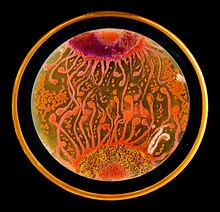Microbial art
In order to preserve a piece of microbial art after a sufficient incubation, the microbe culture is sealed with epoxy.
Suitable species of bacteria (with their colours) include Bacillus subtilis (cream to brown), Chromobacterium violaceum (violet), Escherichia coli (colourless), Micrococcus luteus (yellow), Micrococcus roseus (pink), Proteus mirabilis, Pseudomonas aeruginosa (brown), Pseudomonas fluorescens (naturally blue-green fluorescent with pyoverdine), Serratia marcescens (pink or orange), Staphylococcus aureus (yellow), and Vibrio fischeri (bioluminescent).
[5] A technique called "bacteriography" involves selectively killing certain areas of a bacterial culture with radiation in order to produce artistic patterns.
[10] The biochemist Roger Tsien won the 2008 Nobel Prize in Chemistry for his contributions to knowledge of green fluorescent protein (GFP) that has been used to create art-like works.
[12] The 2015 edition covered 85 submissions, of which microbial art created by Mehmet Berkmen and Maria Peñil called Neurons won first place.

